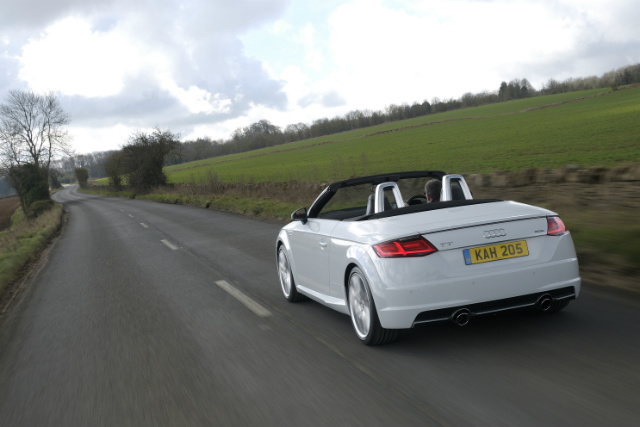I don't enjoy wind-in-the-hair motoring, and partly because an open version of a previously roofed car is bound to suffer from the dreaded scuttle shake, causing creaks and groans and, often, unpleasant handling.
Well, most of them do, anyway. The one that exhibits these traits to the smallest extent I've found in any convertible costing less than £100,000 is the Audi TT Roadster.
Everything I know about body structures tells me that the Roadster ought to feel like it's trying to shake itself to bits every time it encounters a road surface that couldn't be used in an emergency as a snooker table, but it just doesn't. This is the very best thing about the Roadster - better even than the graphics on the digital instrument/satnav display, which are, like those on all TTs launched in 2015, magnificent.
If TTs in general rode and handled well, this might be the first convertible I would ever have considered buying new. Unfortunately, all of them, including the high-performance TTS variant, have drawbacks.
The steering is wonderful, for sure. It's what happens after you've turned the wheel that's the problem. The front end is just too soft, even if you've chosen the firmest damper setting in the drive select menu, so after a sharp turn-in the nose falls over to one side, then rears up if you apply a lot of power. The TT may look like a sports car, but it doesn't drive like one.
Audi has stuck with what once seemed like an old-fashioned policy of providing its convertibles with fabric roofs rather than metal ones. The roof of the Roadster does a good job of minimising external sounds. Like the Coupe, however, this is not a peaceful car, with enough road and wind noise at a 60mph cruise to drown out the 2.0-litre TDI ultra diesel engine, which itself isn't particularly quiet.

It's good, though. It's the least powerful in the TT range, but at 181bhp it's hardly feeble, and it performs very well at low revs. 0-62mph in 7.3 seconds (two tenths slower than the Coupe with the same engine) and a top speed of 150mph may not be startling figures. They're adequate though, particularly in view of how underwhelming the car is through corners.
Combined fuel economy is 65.7mpg, and while not many people will achieve that it's very easy to average over 50mpg without trying hard. Vehicle Excise Duty payments are just £30 from year two onwards. The fact that the ultra is actually cheaper than the 2.0 TFSI petrol car (a situation which may well be reserved at resale time) seals the financial deal in its favour.
The test car was in Sport rather than the more expensive S line trim, and would cost £31,995 without optional extras.
It's not short of equipment, being blessed with DAB digital radio and Bluetooth connectivity as standard (though no USB ports that I could see). You have to pay extra for leather upholstery, heated seats, lane assist, electronic climate control and rear parking sensors. These and other goodies took the value of the test car above £37,000, which may be more the sort of money buyers are prepared to spend.
The boot volume is 280 litres, compared with 305 litres for the Coupe, and isn't affected by whether the roof is up or down, since it's stored in a separate compartment. Interior storage space is also limited compared with the Coupe, whose seats aren't much use for adults but do at least provide somewhere for you to put things.
The Roadster has no rear seats at all, though it’s likely that people who want it are less interested than Coupe customers in matters of practicality.



